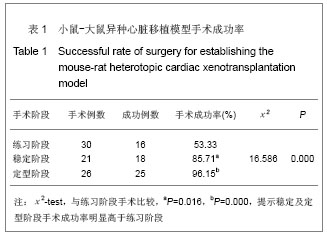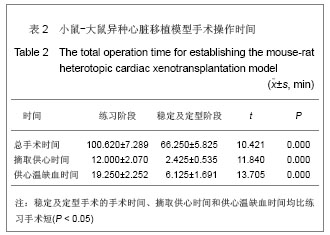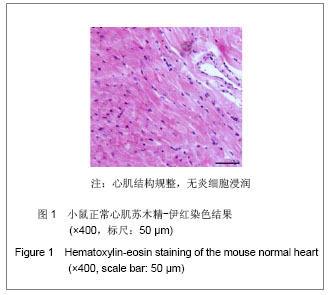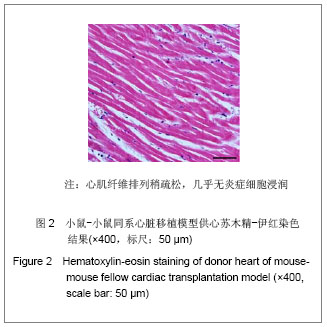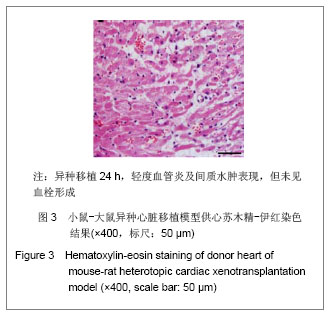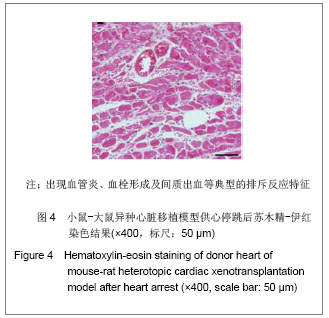| [1] Zhou S, Peng LK, Xie XB, et al. Zhongguo Zuzhi Gongcheng Yanjiu yu Linchuang Kangfu. 2010;14(44):8283-8287.周松,彭龙开,谢续标,等. 异种器官移植的研究进展[J]. 中国组织工程研究与临床康复,2010,14(44):8283-8287.[2] Dou KF, Li X, Li JJ, et al. Zhonghua Qiguan Yizhi Zazhi. 2012; 33(3):184-188.窦科峰,李霄,李俊杰,等. 异种器官移植研究的主要问题与对策[J]. 中华器官移植杂志,2012,33(3):184-188.[3] Chu J, Yu YB, Zhang SH, et al. Shandong Yiyao. 2011;51(44): 112-113.储建,禹亚彬,章世海,等. 异种器官移植的研究进展[J]. 山东医药,2011,51(44):112-113.[4] Mendicino M, Liu M, Ghanekar A, et al. Targeted deletion of Fgl-2/fibroleukin in the donor modulates immunologic response and acute vascular rejection in cardiac xenografts. Circulation. 2005;112(2):248-256.[5] Hosiawa KA, Wang H, Devries ME, et al. CD80/CD86 costimulation regulates acute vascular rejection. J Immunol. 2005;175(9):6197-6204.[6] Won JY, Ahn KS, Sorrell AM, et al. Cytolytic assessment of hyperacute rejection and production of nuclear transfer embryos using hCD46-transgenic porcine embryonic germ cells. Zygote. 2009;17(2):101-108.[7] Liu B, Cheng C, Wu Y, et al. Transgenic mice designed to express human alpha-1,2-fucosyltransferase in combination of human DAF and CD59 to avoid xenograft rejection. Sci China C Life Sci. 2008;51(3):199-204.[8] Su S. Zhonghua Qiguan Yizhi Zazhi. 2007;28(4):251-252.苏松. 小鼠器官移植模型的现状和展望[J]. 中华器官移植杂志,2007,28(4):251-252.[9] Tao R, Wang L, Han R, et al. Differential effects of B and T lymphocyte attenuator and programmed death-1 on acceptance of partially versus fully MHC-mismatched cardiac allografts. J Immunol. 2005;175(9):5774-5782.[10] Tomita Y, Zhang QW, Matsuzaki G, et al. Absent mRNA accumulation of Th1 or Th2 cytokines in heart allografts with chimerism-based drug-induced tolerance. Surg Today. 2005; 35(5):364-370.[11] Qi F, Zhu LW, He XH, et al. Tianjin Yike Daxue Xuebao. 2010; 16(4):559-562.戚峰,朱理玮,何向辉,等. 多靶点联合用药抑制小鼠到大鼠异种心脏移植排斥反应[J]. 天津医科大学学报,2010,16(4):559-562.[12] Cooper DK, Teuteberg JJ. Pig heart xenotransplantation as a bridge to allotransplantation. J Heart Lung Transplant. 2010; 29(8):838-840.[13] Manji RA, Menkis AH, Cooper DK. Cardiac xenotransplantation technology provides materials for improved bioprosthetic heart valves. J Thorac Cardiovasc Surg. 2011;142(1):238-239, 239.[14] Huang XS, Liu X, Chen DZ, et al. Zhongguo Xiufu Chongjian Waike Zazhi. 2005;19(7):583-586.黄雪珊,刘璇,陈道中,等. 改良Heron法建立异种异位心脏移植模型[J]. 中国修复重建外科杂志,2005,19(7):583-586.[15] Tang H, Yao ZX, Liu SC, et al. Zhongguo Xiandai Yixue Zazhi. 2008;18(1):21-24.唐华,姚榛祥,刘盛春,等. 鼠异种异位心脏移植模型建立与病理特征观察[J]. 中国现代医学杂志,2008,18(1):21-24.[16] Wei L, Wang M, Qu X, et al. Differential expression of microRNAs during allograft rejection. Am J Transplant. 2012; 12(5):1113-1123.[17] Chen WW, Yang YR, Xia P, et al. Wenzhou Yixueyuan Xuebao. 2011;41(3):252-254.陈文伟,杨亦荣,夏鹏,等. 小鼠颈部异位心脏移植手术的改良[J]. 温州医学院学报,2011,41(3):252-254.[18] Wang JX, Huang SD, Xu ZY, et al. Tongji Daxue Xuebao. 2008; 29(1):106-108.王建雄,黄盛东,徐志云,等. 改良移植技术建立豚鼠至大鼠异位心脏移植模型[J]. 同济大学学报: 医学版, 2008,29(1):106-108.[19] Zhang SL, Sun ZQ. Zhongguo Zuzhi Gongcheng Yanjiu yu Linchuang Kangfu. 2010;14(31):5883-5886.张松林,孙宗全. 应用Tail-cuff技术改良小鼠颈部异位心脏移植模型[J]. 中国组织工程研究与临床康复, 2010,14(31): 5883-5886.[20] Postrach J, Bauer A, Schmoeckel M, et al. Heart xenotransplantation in primate models. Methods Mol Biol. 2012;885:155-168.[21] Choi HJ, Kim MK, Lee HJ, et al. Effect of alphaGal on corneal xenotransplantation in a mouse model. Xenotransplantation. 2011;18(3):176-182.[22] Hawthorne WJ, Simond DM, Stokes R, et al. Pre-clinical model of composite foetal pig pancreas fragment/renal xenotransplantation to treat renal failure and diabetes. Xenotransplantation. 2011;18(6):390-399.[23] Luca G, Calvitti M, Mancuso F, et al. Reversal of experimental Laron Syndrome by xenotransplantation of microencapsulated porcine Sertoli cells. J Control Release. 2012.[24] Li C, Luo L, Lu J, et al. A modified splint tubing technique for heterotopic heart transplantation in mouse. Transpl Immunol. 2011;25(1):82-87.[25] Jiang XF, Zhu L, Cui ZM, et al. Zhongguo Puwai Jichu yu Linchuang Zazhi. 2010;17(9):914-916.姜晓峰,朱磊,崔哲铭,等. 一种改良的吻合法小鼠腹腔异位心脏移植模型[J]. 中国普外基础与临床杂志,2010,17(9):914-916.[26] Yan GF, Zhang J, Zhou Y, et al. Shiyan Dongwu yu Bijiao Yixue. 2008;28(5):341-342.严国锋,张健,周勇,等. 保温措施对小鼠麻醉效果的影响[J]. 实验动物与比较医学,2008,28(5):341-342.[27] Hansen TN, Haworth RA, Southard JH. Warm and cold ischemia result in different mechanisms of injury to the coronary vasculature during reperfusion of rat hearts. Transplant Proc. 2000;32(1):15-18.[28] Li S, Guan Q, Chen Z, et al. Reduction of cold ischemia-reperfusion injury by graft-expressing clusterin in heart transplantation. J Heart Lung Transplant. 2011;30(7): 819-826.[29] Brenner P, Keller M, Beiras-Fernandez A, et al. Prevention of hyperacute xenograft rejection through direct thrombin inhibition with hirudin. Ann Transplant. 2010;15(4):30-37.[30] Schumacher M, Van Vliet BN, Ferrari P. Kidney transplantation in rats: an appraisal of surgical techniques and outcome. Microsurgery. 2003;23(4):387-394. |
